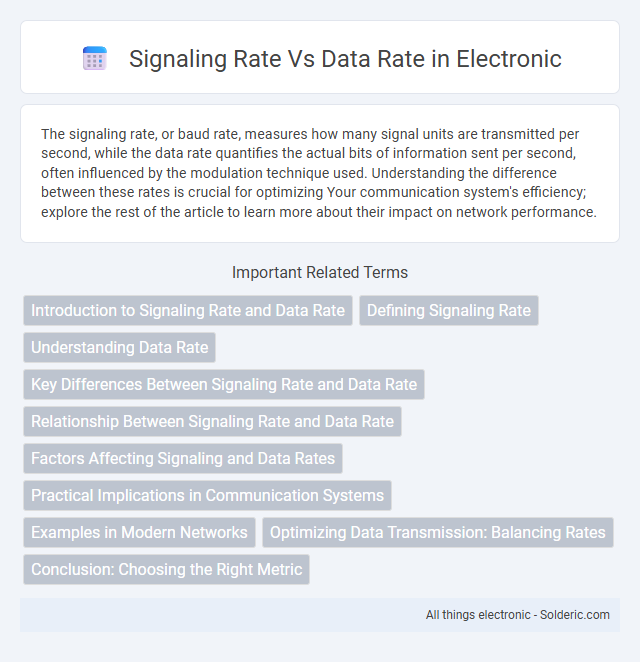The signaling rate, or baud rate, measures how many signal units are transmitted per second, while the data rate quantifies the actual bits of information sent per second, often influenced by the modulation technique used. Understanding the difference between these rates is crucial for optimizing Your communication system's efficiency; explore the rest of the article to learn more about their impact on network performance.
Comparison Table
| Aspect | Signaling Rate | Data Rate |
|---|---|---|
| Definition | Number of signal changes or symbols transmitted per second | Amount of actual data transmitted per second |
| Unit | Baud (symbols per second) | Bits per second (bps) |
| Focus | Symbol transmission speed | Effective information throughput |
| Relation | Signaling rate x bits per symbol = Data rate | Depends on signaling rate and modulation scheme |
| Example | 1,000 baud = 1,000 symbols per second | 2,000 bps if each symbol encodes 2 bits |
Introduction to Signaling Rate and Data Rate
Signaling rate refers to the number of signal changes or symbols transmitted per second, measured in baud, which directly impacts the efficiency of data communication systems. Data rate, measured in bits per second (bps), indicates the actual amount of data transmitted over a communication channel within a given time frame. Understanding the difference between signaling rate and data rate helps you optimize network performance by selecting appropriate modulation techniques and bandwidth allocations.
Defining Signaling Rate
Signaling rate, also known as baud rate, refers to the number of signal changes or symbols transmitted per second in a communication channel. It measures how frequently the signal waveform varies, directly impacting the transmission speed of encoded data. Unlike data rate, which indicates the number of bits transmitted per second, signaling rate focuses on symbol intervals, with each symbol potentially representing multiple bits depending on the modulation scheme.
Understanding Data Rate
Data rate measures the total amount of data transmitted per second, often expressed in bits per second (bps), reflecting the actual throughput of a communication system. Signaling rate, or baud rate, indicates how many signal changes or symbols occur per second but does not directly equate to data rate when multiple bits are encoded per symbol. Understanding data rate requires considering modulation techniques that encode multiple bits per signal change, enabling higher data rates than the signaling rate alone suggests.
Key Differences Between Signaling Rate and Data Rate
Signaling rate refers to the number of signal changes or symbols transmitted per second, measured in baud, while data rate indicates the actual amount of data transmitted per second, measured in bits per second (bps). The primary difference lies in the fact that each signal change can represent multiple bits, depending on the modulation scheme used, causing the data rate to often exceed the signaling rate. Understanding the distinction between signaling rate and data rate helps you optimize communication systems for efficiency and bandwidth utilization.
Relationship Between Signaling Rate and Data Rate
Signaling rate refers to the number of signal changes or symbols transmitted per second, affecting the speed at which data is encoded on the communication channel. Data rate, measured in bits per second (bps), represents the actual quantity of useful information transmitted over time, influenced by both signaling rate and bits conveyed per symbol. Higher signaling rates can increase data rates, but modulation schemes that encode multiple bits per symbol enable achieving high data rates without proportionally increasing the signaling rate, optimizing bandwidth efficiency.
Factors Affecting Signaling and Data Rates
Signaling rates are influenced by factors such as channel bandwidth, modulation schemes, and signal-to-noise ratio, determining how many signal changes occur per second. Data rates depend on coding efficiency, error correction methods, and the number of bits transmitted per signal change, impacting the actual throughput. Both rates are constrained by physical media characteristics and technological limitations of transmitting and receiving equipment.
Practical Implications in Communication Systems
Signaling rate determines how many signal changes occur per second, directly impacting the maximum achievable data rate in communication systems. Your system's performance depends on balancing signaling rate with modulation schemes to optimize bandwidth usage and minimize errors due to noise or interference. Efficient management of signaling rate enhances data throughput and overall communication reliability in practical applications.
Examples in Modern Networks
Signaling rate refers to the number of signal changes or symbols transmitted per second, while data rate indicates the actual amount of user data transmitted per second in bits. In modern networks like 5G, signaling rates can reach up to several gigabaud, but the data rate depends on modulation schemes such as 256-QAM, enabling multi-gigabit per second transmission speeds. Your network's performance hinges on both high signaling rates and efficient encoding techniques to maximize throughput and minimize latency.
Optimizing Data Transmission: Balancing Rates
Optimizing data transmission requires balancing the signaling rate and data rate to maximize efficiency and minimize errors. Signaling rate refers to the number of signal changes per second, while data rate represents the actual amount of information transmitted per second, often influenced by modulation schemes. Your system's performance improves when these rates are aligned to reduce bandwidth usage without sacrificing data integrity.
Conclusion: Choosing the Right Metric
Choosing the right metric between signaling rate and data rate depends on the specific context of network performance evaluation. Signaling rate measures the frequency of signal changes per second, directly impacting the bandwidth efficiency and quality of the communication channel. Data rate quantifies the actual volume of data transmitted per second, reflecting user experience and effective throughput in practical applications.
Signaling rate vs data rate Infographic

 solderic.com
solderic.com